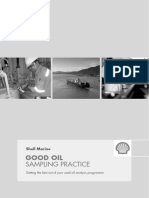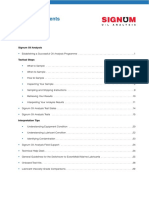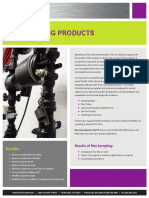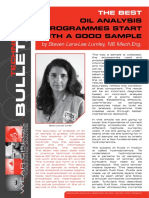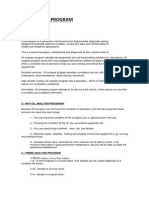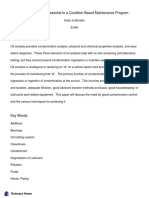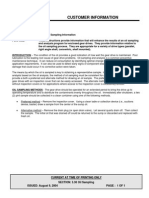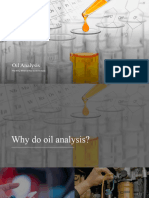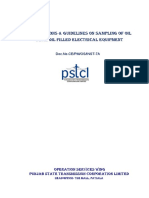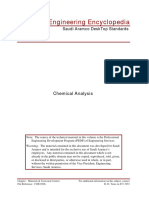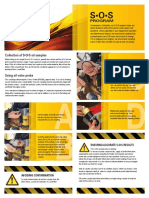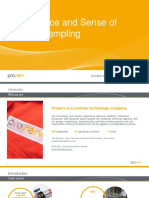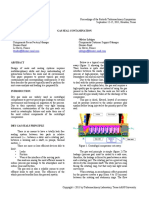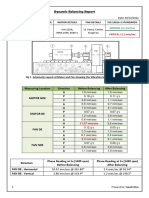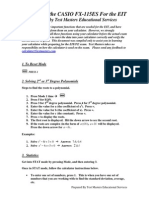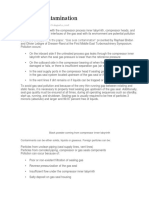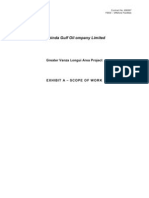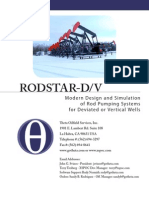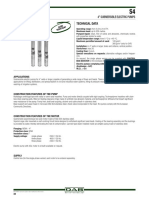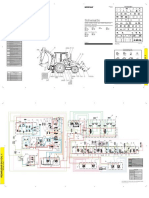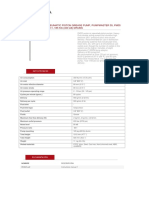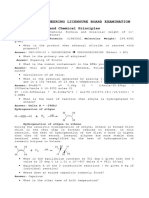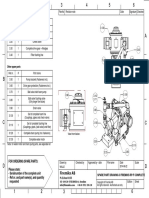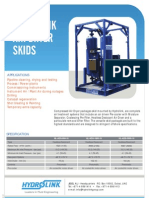OIL SAMPLING
FUNDAMENTALS
�Outline
• Definition & Objectives
– What is the goal of Oil Sampling?
• Sampling Tools
– What are the best tools for drawing a sample?
• Sampling Methods, Locations and Procedures
– Where is the best location for drawing a sample?
– What is the best method for effective sampling?
• Equipment Specific Sampling
– Where should a sample be pulled from a reservoir?
– Where should a sample be pulled on a circulating system?
• Sampling Frequency
– How to determine how often samples should be pulled?
2
�Oil Sampling Defined
The process of taking a portion of oil from a tank,
reservoir, or oil sump for the specific purpose of
using it for Oil Analysis. This sample should best
represent the oil working area in equipment or oil
turbulent area in a tank or reservoir.
3
�Oil Sampling – The Goal
• Maximize data density
– Samples should reflect the current status of the lubricant and the machine.
Samples should contain the most amount of representative data possible.
• Minimize data disturbance
– Data disturbance or noise in the sample can produce false positives during
testing and analysis. Following best practice for sample extraction, sample
location and the correct oil analysis test slate will help reduce or eliminate
data disturbance.
• Sample at the proper frequency
– Sampling at the proper frequency will allow us to trend the data and identify
problems associated with the lubricant or the machine not just when a limit is
breached, but when an abnormal rate of change is acknowledged.
4
�Oil Sampling – The Goal
Must Reflect: While Maintaining:
• Lubricant condition • Safe environment
• Machine condition • Sample integrity
– Method
– Tools
– Handling
5
�Garbage In = Garbage Out
(Oil Sampling) = (Oil Analysis)
• Poor planning • Poor oil analysis reports
• Poor execution • Improper corrective actions
6
�OIL SAMPLING
TOOLS
�Oil Sampling Ports
• Hydraulic sample ports are used on
smaller tanks or pipes.
• Pipe installation should be on an elbow
with flow coming toward the port.
This style of test port can be installed in a pressurized port up 5000PSI.
8
�Pitot Tube Sampling
• Sample tubes (pitot) are used for non-pressurized applications.
• Used for reaching turbulent zones of oil in larger reservoirs.
• Complete assembly consists of a sample port, sampling tube
and an optional swivel.
• Various lengths and thread configurations to meet the
application needs
• Available in fixed or universal configurations
• Stainless Steel options.
9
�Level Gauge & Pitot Tube Sampling
• Providing multiple solutions in
one port.
• Existing level gauge is removed
and replaced with a modified
sampling unit.
10
�Vacuum Pump
• A vacuum pump is used to extract sample from
non-pressurized and drum sampling. Care must
be taken to ensure that the internals of the
pump are kept in good condition and not
contaminated with oil, dirt, water, etc.
11
�Sample Port Adapter
• Sample port adapters are use to open
the ball valve in the sample ports
allowing fluid to flow through.
• Black caps indicate high flow valves.
12
�OIL SAMPLING
METHODS
�Improper Oil Reservoir Sampling
• Are there safety issues with this type of method?
• Are there concerns with contamination ingression
during sampling?
• Is the sample consistent each time it is taken?
14
�Drain Sampling
Method Pros Cons
Drain Sampling • Inexpensive • Accessibility issues
• No installation required • Risky when sampling
during operation
• Suitable for testing
homogenous properties • Tough to get
representative sample
• Requires significant
flushing
15
�Drop Tube Sampling
Method Pros Cons
Drop Tube • Cost effective • Exposes open system to
Sampling environment
• Difficult to ensure
consistent location
• Risk of tube getting caught
in system while sampling
16
�Sampling Port / Pitot Tube Sampling
Method Pros Cons
Drop Tube Sampling • Cost effective • Exposes open system to environment
• Difficult to ensure consistent location
• Risk of tube getting caught in system while sampling
17
� OIL SAMPLING
PORT / PITOT TUBE
INSTALLATION
METHODS
�Circulating Systems Installation
After Component,
Before Return Line
After Pump
Return Before Filter,
Line End After Filter
• Installation of forced lubrication system require the sample
port installed after the component.
• Direction of the path of flow must be known along with
installation of the sample port in a turbulent area.
19
�Hydraulic Method
Pressurized Filtration System
From Filter
Housing
Hose / Tubing from Filter Housing
• Hose or tubing from the fluid flow exit of the filter housing is removed
and replaced by a hydraulic tee and appropriate hardware.
• Sample port is installed so that the flow of the fluid is directed at the
Sample port.
– This creates a turbulent zone for samplings and removes the opportunity
of particle fly-by which is common in laminar flow installations.
20
�Hydraulic Method
Standard Operating Procedure –
Pressurized System
21
�Hydraulic Method
Pressurized Gauge Installation Method
From Gauge Port
Replace Gauge or Sensing Line Connection
• Hose, tubing or the pressure gauge from the main system pressure port
is removed and replaced by a hydraulic tee and appropriate hardware.
• Sample port is installed so that the flow of the fluid is directed at the
Sample port.
– This creates a turbulent zone for sampling and removes the opportunity of particle
fly-by which is common in laminar flow installations.
22
�Hydraulic Method
Pressurized Cooler Installation
• Remove cooler pressure
port plug (if equipped) Fluid Flow Cooler
and replace with the
appropriate size of
hydraulic sample port.
23
�Hydraulic Reservoir Installation
• Installation in a hydraulic reservoir require the
pitot tube to be installed at approximately ½ the
height of the liquid level in a turbulent area.
Watch for baffles internally.
24
�Gearbox Housing Installation
Using an Alternate or Second Drain Port
Reducer Bushing (if required)
Drain hole size to 1/4 NPT
• Standard sample tube assembly
– Use universal sample port if a substantial bend is required.
25
�Gearbox Housing Installation
Installation of the Pitot Tube
• These units are field fit to ensure
the tube end is off the bottom of
the reservoir and in an area where
oil is circulating.
• Caution is required to ensure tube
assembly does not interfere with
internal gearing.
26
�Standard Operating Procedure –
Non-Pressurized System
27
�Gearbox Housing Installation I
Maintaining a Drain Port
Standard Nipple
Standard Black, Hydraulic
Standard Drain Plug or Stainless Tee
• This method does not require the pitot tube to be removed to
drain the lubricant.
28
�Gearbox Housing Installation II
Sampling Gearboxes
with a Gearbox Kit
29
�Pump Housing Method
Drain Plug
• Ensure pitot tube end is located
off the bottom of the housing but
no higher than ½ the level of the
fluid during operation.
30
�Standard Operating Procedure –
Bearing Housings without
Sampling Devices
31
�55 Gallon Drum Kit
Sampling Stored Oil
32
�Standard Operating Procedure –
55 Gallon Tank
33
�Summary – Sampling Methods
Best Practices Not So Good Practices
• Ensure machines are running and at • Sampling systems that are not running or not
operating temperature. at typical operating temperatures.
• Sample in turbulent area that are • Sampling from drain port.
representative of critical load zones.
• Sampling with a drop-tube.
• Install permanently mounted hardware for
consistent sampling Ex. Pitot Tubes, test • Inconsistent sampling points and methods.
ports, etc. • Sampling shortly after oil changes.
• Flushed sampling valves and sampling • Using tubing more than once causing cross
hardware. contamination of oil.
• Keep the bottles clean. • Sampling without adequate flushing.
• Sampled at proper frequency. • Waiting too long before sending samples to
• Samples forwarded to lab immediately. the lab.
• Follow safety procedures.
34
�Frequency Factors
Frequency depends on many factors but one of the
most important is to base the frequency on the
equipment criticality from an RCM or similar analysis.
• Environmental Severity • Economic Penalty of Failure
– High dust and moisture – Safety risk
– High loads, pressures and speeds – Downtime cost
– High running temperature – Repair cost
– Duty cycle, shocks, or vibration – Mission criticality
– Chemical or radiation contamination
35
�The Roadmap to Success
Oil Sampling
Representative
Sample Location
Oil Analysis
Correct Use of Proper Sample
Sampling Accessories Preparation
Oil Sampling SOP Calibrated Lab Proper Testing
Instruments Methods
Oil Sample
Oil Sample Extraction Certified Lab
Sent to Lab
Techs
36
�Need Help?
• Choosing hardware
• Installation
• Training
Talk to Trico – the team behind Lubricology




